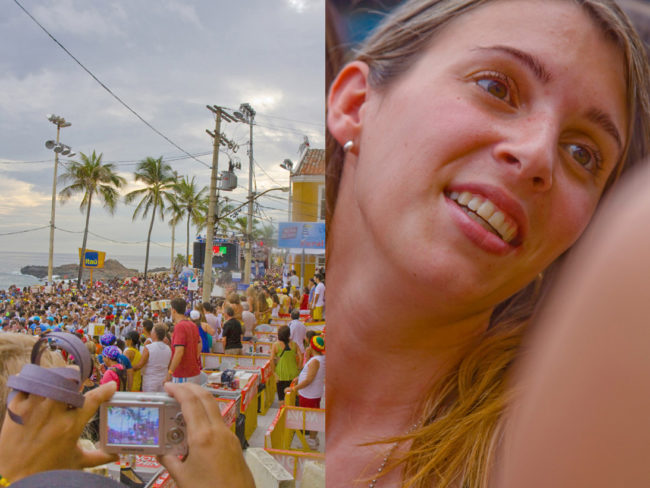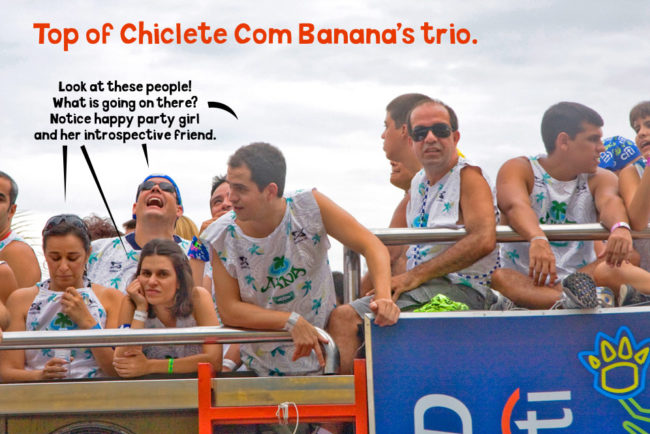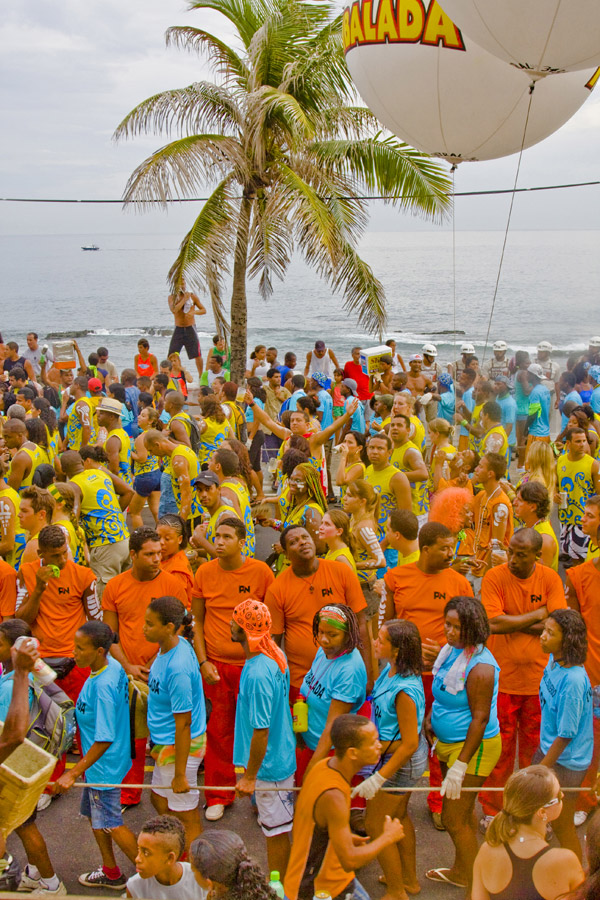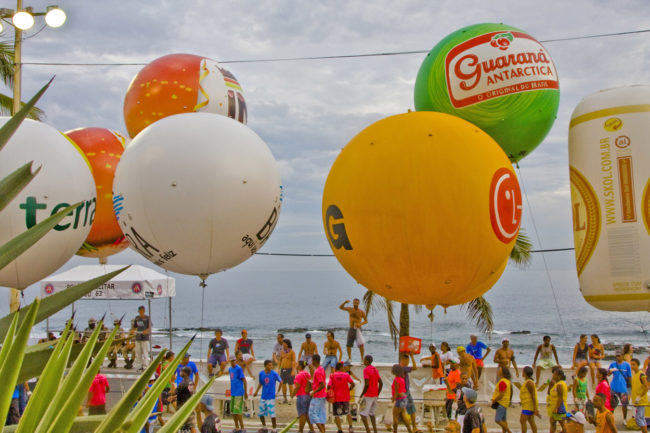Second night of Carnaval in Salvador–part 2


There’s a lot more to this than meets the eye. First of all, there are the trios elétricos. The first official t e took place in 1950, when three Bahian guys figured out how to wire a guitar to a car battery, and took off down Rua Chile on Carnaval Day, playing music from the moving car, a 1929 Model A Ford, known as the fobica. The novelty of the whole thing brought the people out in droves, who followed the car, singing and dancing.
Up until the 70s, the trios were more like parade floats, and the music was instrumental. Until everybody heard Caetano Veloso sing, “The only ones not dancing behind the trio elétrico are those who are already dead,” and the moving Brazilian party band was born.
Bell Marques’ group further refined the sound quality in the 80s, when the trios elétricos were turned into giant creeping boom boxes with the talent on top. By now, they are state of the art wonders, with full recording capability inside, huge dressing rooms that are for the stars, and a sound that would make both Mozart and Joey Ramone cry. In heaven. Together. They’re probably friends. That Mozart was irascible.

So now you see that people also ride on top of the trios elétricos, too. Obviously people with a lot of cash, because David paid a good bit for his ticket to be in the street. Although many would prefer to be in the street, I think I might like this kind of participation. In addition to the big music truck, there’s another truck the same size that follows behind the music. In that behemoth, there are restrooms, concessions, first aid, and a place to sit down if you’re too tired to make the 6 to 8 hour parade route on your feet.
You can see that everybody on top of the trio are wearing the same t-shirt. That identifies them as eligible 2008 members of Nana Banana, which is the name of Bell Marques’ bloco, like Os Mascarados was Margareth Menezes’ bloco name.
Notice the rabid motion of the people behind the trio. There are of course two schools of thought on whether it’s better to be in front of the music or behind it. The main advantage to being behind it is that the concession/bathroom truck is following closely on your heels.
Here’s David Breedlove with his matching Nana Banana t-shirt and stylish do-rag. He’s in the Nana Banana bloco, dancing, marching, and jumping up and down for as many blocks as he can handle. I never did find out how long he went, but Carol will tell me. Mrs. Breedlove, meanwhile, was on the patio of the Bahia Flats with us, and left right after David went by. She gets plenty of Carnaval in about an hour. Kind of like a very light skinned person gets red at the beach quickly. About that fast.
 “Bloco, schmoco!” you are shouting at your screen. “Tell me more, Ben!”
“Bloco, schmoco!” you are shouting at your screen. “Tell me more, Ben!”
The bloco is the name of the thing and the concept: several hundred workers carry a rope that encircles not only the two giant party trucks, but those crazies parading in front, in between, and behind the trucks, too. They all have gloves to hold the ropes, and Carol tells us that people line up for the job. They so much want to be part of the party, whether they’re working or not. And each rope holder gets a t-shirt that identifies them as part of that particular bloco. During the 6 to 8 hour parade, they wear out several pairs of gloves from constant friction on the moving ropes. What would happen in America if we tried to get people to perform this service?
Here are the rope and security folks for Timbalada, who was the group and bloco (same name) after Nana Banana. I guess the concept is, if you can get past the rope and rope handlers, the guys in the orange shirts would deal with you. If they didn’t, the military police was marching up and down the parade route, and was very conspicuous. They weren’t assholes by any means, and only stepped in when needed. They also seemed to be enjoying the festivities as much as anyone
on duty could, while still maintaining an iron exterior. Tough but firm. Kind of like a nice chocolate candy with a cream center from a Whitman’s Sampler. What do I know? They probably would have snapped my neck if I had gotten out of line. Creamy center indeed!
The whole concept of the rope and cost to parade in a bloco is a heated controversy in Salvador. There are those who claim it is elitist, and there are those that scoff at the notion. I tend to side with the scoffers. In addition to the fact that the music and festivities are free to everyone, there are trios that have no ropes, and allow anyone to parade with them. Elitist indeed! When there are no ropes and no bloco, the people that march around the trio are called pipoca, meaning “popcorn”, because they are inevitably going to be jumping up and down during the parade.
The trios were all heavily corporate sponsored, as attests the side of Timbalada’s truck, in addition to the butt-load of balloons with logos on them that preceded and followed each group.


